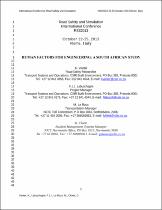JavaScript is disabled for your browser. Some features of this site may not work without it.
- ResearchSpace
- →
- Research Publications/Outputs
- →
- Conference Publications
- →
- View Item
| dc.contributor.author |
Venter, Karien

|
|
| dc.contributor.author |
Labuschagne, FJJ

|
|
| dc.contributor.author |
Le Roux, M

|
|
| dc.contributor.author |
Cloete, G

|
|
| dc.date.accessioned | 2013-12-17T13:41:34Z | |
| dc.date.available | 2013-12-17T13:41:34Z | |
| dc.date.issued | 2013-10 | |
| dc.identifier.citation | Venter, K, Labuschagne, F.J.J, Le Roux, M and Cloete, G. 2013. Human factors for engineering: A South African study. In: Road Safety and Simulation International Conference RSS2013, Rome, Italy, 22-25 October 2013 | en_US |
| dc.identifier.uri | http://hdl.handle.net/10204/7125 | |
| dc.description | Road Safety and Simulation International Conference RSS2013, Rome, Italy, 22-25 October 2013. Pre-print attached. | en_US |
| dc.description.abstract | Worldwide, fatigue has been cited as a contributory cause in heavy vehicle crashes. In South Africa very little scientific evidence is available to support or reject this notion. A study was commissioned to investigate the role fatigue plays on a specific 100 km stretch of highway in the Free State province of South Africa. The section in question is a dual carriage way, in a predominantly rural environment and access to the road is limited and controlled. This road is of strategic importance and approximately a third of all traffic is heavy vehicles transporting goods between the economic hub of Johannesburg and the busy seaport of Durban. The study comprised of a detailed road safety engineering assessment and a human factor (fatigue) study. Heavy vehicle crashes constitutes almost half of all the crashes occurring on the stretch of road. The crash analysis revealed that this section of the road has an over-representation of roll-over, rear-end and side swept crashes. Internationally these types of crashes have been associated with fatigue. The study section has been described as “boring” and “long” by the drivers participating in the fatigue survey. This paper provides a brief overview of the findings from site inspection, health assessment and crash analysis. The paper then reports on the driver fatigue study where self-reported questionnaires were administered to drivers frequenting the road. Driver responses contributed to a better understanding of where and when fatigue sets in on the N3 Route. The fatigue study provided the researchers with a better understanding of the context in which fatigue occur. The paper concludes with recommendations for engineering measures which could potentially alleviate fatigue along the N3 Route. | en_US |
| dc.language.iso | en | en_US |
| dc.relation.ispartofseries | Workflow;11874 | |
| dc.subject | Heavy vehicle crashes | en_US |
| dc.subject | Road safety | en_US |
| dc.subject | Driver fatigue | en_US |
| dc.subject | Driver monotony | en_US |
| dc.subject | Engineering measures | en_US |
| dc.title | Human factors for engineering: A South African study | en_US |
| dc.type | Conference Presentation | en_US |
| dc.identifier.apacitation | Venter, K., Labuschagne, F., Le Roux, M., & Cloete, G. (2013). Human factors for engineering: A South African study. http://hdl.handle.net/10204/7125 | en_ZA |
| dc.identifier.chicagocitation | Venter, Karien, FJJ Labuschagne, M Le Roux, and G Cloete. "Human factors for engineering: A South African study." (2013): http://hdl.handle.net/10204/7125 | en_ZA |
| dc.identifier.vancouvercitation | Venter K, Labuschagne F, Le Roux M, Cloete G, Human factors for engineering: A South African study; 2013. http://hdl.handle.net/10204/7125 . | en_ZA |
| dc.identifier.ris | TY - Conference Presentation AU - Venter, Karien AU - Labuschagne, FJJ AU - Le Roux, M AU - Cloete, G AB - Worldwide, fatigue has been cited as a contributory cause in heavy vehicle crashes. In South Africa very little scientific evidence is available to support or reject this notion. A study was commissioned to investigate the role fatigue plays on a specific 100 km stretch of highway in the Free State province of South Africa. The section in question is a dual carriage way, in a predominantly rural environment and access to the road is limited and controlled. This road is of strategic importance and approximately a third of all traffic is heavy vehicles transporting goods between the economic hub of Johannesburg and the busy seaport of Durban. The study comprised of a detailed road safety engineering assessment and a human factor (fatigue) study. Heavy vehicle crashes constitutes almost half of all the crashes occurring on the stretch of road. The crash analysis revealed that this section of the road has an over-representation of roll-over, rear-end and side swept crashes. Internationally these types of crashes have been associated with fatigue. The study section has been described as “boring” and “long” by the drivers participating in the fatigue survey. This paper provides a brief overview of the findings from site inspection, health assessment and crash analysis. The paper then reports on the driver fatigue study where self-reported questionnaires were administered to drivers frequenting the road. Driver responses contributed to a better understanding of where and when fatigue sets in on the N3 Route. The fatigue study provided the researchers with a better understanding of the context in which fatigue occur. The paper concludes with recommendations for engineering measures which could potentially alleviate fatigue along the N3 Route. DA - 2013-10 DB - ResearchSpace DP - CSIR KW - Heavy vehicle crashes KW - Road safety KW - Driver fatigue KW - Driver monotony KW - Engineering measures LK - https://researchspace.csir.co.za PY - 2013 T1 - Human factors for engineering: A South African study TI - Human factors for engineering: A South African study UR - http://hdl.handle.net/10204/7125 ER - | en_ZA |






